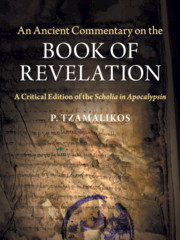Book contents
- Frontmatter
- Contents
- Preface
- Exordium
- Abbreviations
- Introduction
- Part I Text of Revelation and Scholia in Apocalypsin
- Part II Expanded Notes to the Scholia
- Bibliography
- Index of authors cited in the scholia
- Index of Names in the Scholia
- Index of terms in the scholia
- Biblical citations in the scholia
- Index of modern authors
- General index
- References
Introduction
Published online by Cambridge University Press: 05 August 2014
- Frontmatter
- Contents
- Preface
- Exordium
- Abbreviations
- Introduction
- Part I Text of Revelation and Scholia in Apocalypsin
- Part II Expanded Notes to the Scholia
- Bibliography
- Index of authors cited in the scholia
- Index of Names in the Scholia
- Index of terms in the scholia
- Biblical citations in the scholia
- Index of modern authors
- General index
- References
Summary
The Codex
Codex 573 of the Metamorphosis cloister (the Μεγάλον Μετέωρον, the Great Meteoron) is a little token of the fate of old treasures of all kinds over the centuries. More specifically, it betokens the conflict waged in Greece in 1882, over preservation of extant manuscripts, shortly after Greece had become an independent state, after the annexation of Thessaly, while Northern Greece was still under the rule of Ottoman Turks. One facet of this battle was the enterprise by the newly independent state to bring all manuscripts that had remained after centuries of looting together for preservation in the National Library in Athens. This story I will relate shortly. Another facet of this battle is the one between scholars striving to capture the glory of originality in recording and cataloguing manuscripts. This story I will not relate, since this is the same everywhere in the world of scholars.
In the seventeenth century, a Cypriot monk called Athanasius had bought manuscripts from Meteora by weight. During the eighteenth and early nineteenth centuries, monks used to sell manuscripts to visitors from Western Europe. However disturbing to later locals the phenomenon may have appeared, this was the cause for many texts being saved and respected. When the government sent two savants to collect manuscripts for the National Library in Athens (in the late nineteenth century), this resulted in a real war between the peasants (including wives and children) and the state military force. Locals saw the removal of manuscripts from Meteora to the National Library of Athens as either a sacrilege, or appropriation of treasures belonging to the convents. Earlier still, the two savants, escorted by the same soldiers and faced with the resistance of the monks objecting to the removal of all extant books from the country to the capital, had taken by force all the books that were not hidden, and packed them in cases. However, the peasants who fell upon the military convoy, proved victorious. As a result, the government decided to yield to the will of the regional people, and only nine boxes with about 350 manuscripts were taken to Athens to be lodged in the National Library. This was virtually nothing, when one considers that the monastery of Metamorphosis alone has more than six hundred manuscripts.
- Type
- Chapter
- Information
- An Ancient Commentary on the Book of RevelationA Critical Edition of the Scholia in Apocalypsin, pp. 1 - 94Publisher: Cambridge University PressPrint publication year: 2013

